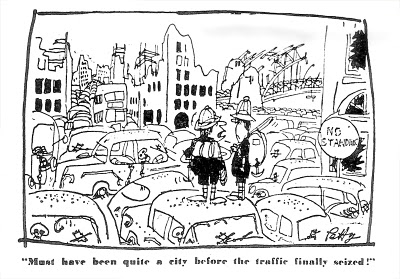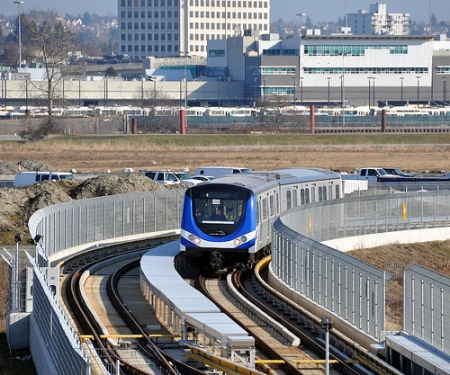A commentary by Lyndon Henry, from the Light Rail Now folks in the United States. The question to be asked here is: “Was Canada so-called stimulus funding successful?”

While the commentary below doesn’t directly mention public
transportation, rail transit, or passenger rail, I believe it is
directly relevant to the issue of federal investment in these
services and facilities (now under political attack). Beinhart makes
a compelling case for investing in major projects as the most
effective way to create jobs – this certainly bolsters the case for
investing in urban rail, Amtrak, and other public transport projects
as a way not only to start addressing America’s dire
infrastructure-decay and capacity-insufficiency problems but also to
significantly create essential, productive jobs.
The author presents one of the best explanations I’ve seen of the
job-creation “multiplier effect” of such investments.
The Teapot GOP (and Blue Dog Dems) have derided the Obama
administration’s 2009 “stimulus” program as a “failure” that cost
$787 billion (exaggerated to “$800 billion” and even more exaggerated
to “$1 trillion”). Beinhart lays out a compelling case that the
“stimulus” was actually mostly tax cuts and unemployment benefit
subsidies, with only $154.5 billion of actual job-creating stimulus.
Based on that figure, and the well-documented creation of at least
1.6 million jobs, he calculates an average cost per created job of
less than $97,000 – a figure that compares extremely well with other
government “efforts” at “job creation” (such as “trickle-down”
effects of high-inome tax cuts).
I think this analysis and these figures will be helpful to rail
advocates in making the case for much more, not less, public
investment in rail transit and intercity rail projects (definitely an
uphill struggle in today’s loony, Neanderthal political climate).
Lyndon
http://www.huffingtonpost.com/larry-beinhart/why-the-stimulus-package_b_781206.html
Huffington Post
November 9, 2010 05:41 PM
Why the Stimulus Package Failed
Larry Beinhart
Author, ‘Salvation Boulevard,” “Wag the Dog,” “The Librarian.”
The stimulus package failed because it consisted mostly of tax cuts.
Tax cuts are among the very worst ways to create jobs and certainly
the most expensive.
The stimulus package authorizes 787 billion dollars. According to the
official website (Recovery.gov) $565 billion has actually been spent
or credited. There are three categories of “stimulus.” Citing amounts
spent, they are:
1. $243.4 billion in tax cuts.
2. $154.5 billion in contracts, grants, and loans. This is what
we actually think of as a stimulus, construction and research projects.
3. $166.8 billion in entitlements. This is mostly money to the
states to help with unemployment insurance.
Estimates of jobs “saved and created” by the package range from
800,000 to 2.4 million (both from the Congressional Budget Office),
with other estimates at 1.25 million (IHS/Global Insight), 1.06
million (Macroeconomic Advisors), and 1.59 million (Moody’s).
Let’s use Moody’s estimate (sort of the high middle, and independent)
and round it off to 1.6 million jobs “saved and created.”
That’s $353,125 per job.
I’m sorry, but that’s ridiculous. It’s obscene.
If you have an essentially unlimited line of credit, as the
government essentially does, it would appear relatively easy to create jobs.
“Hey, you, over there on the unemployment line, wanna work cleaning
up our national parks? Yeah, we’ll give you a twenty dollar rake,
some biodegradable garbage bags, and twenty bucks an hour.” That
happens to be 47 cents an hour over the average wage.
No national parks or monuments in your neighborhood?
All right, there are lots of empty lots and abandoned homes due to
the housing market collapse. “Let’s clean ’em up. Same deal. That’s
forty thousand a year. You can live on that.”
Presumably the government will be decent about it and pay the usual
benefits — social security, unemployment insurance, workman’s comp,
and so on — which adds $8.11 an hour. That’s a little less than
$17,000 a year, making a total cost of $57,000 per year, per job.
Jobs don’t exist in a vacuum, not even sweeping the streets by hand
with a broom. There has to be a certain number of overhead costs. Not
counting salaries of supervisors and such (which would be part of the
job creation numbers), not counting benefits (already in there), 15
percent is a very generous number, for another $8,550, a total of
$65,550 per job.
So that’s what a “created” job should cost. About $65,000.
If you actually want to “create jobs,” that’s how you should do it.
Go out and create them.
But that’s not how we do things. We were not goddamn Communists. Or
even socialists. We’re capitalists. So we give out contracts to
private enterprises and grants to universities and other institutions.
Construction projects, one of the primary forms of job creation has
lots of costs beside labor. They have machinery, materials, a variety
of business expenses (accounting, insurance, legal, etc.), the
purchase of land and so on. Labor accounts for 20-30 percent of a
construction contract. Let’s take the low end, 20 percent, and assume
that a construction job is one of those $65,000 wages plus benefits
for a full year jobs, and the cost of that job then becomes $325,000.
That’s pretty close to the $353,125 per job number we got using the
Moody’s estimate.
Except that all those other construction costs (excluding land
purchase, which should be less relevant here) involve additional
labor. For example, materials are manufactured, a certain portion of
them here, in the US. Truckers transport them. Building supply
company employees handle them. Machinery is built (some portion of it
here), and maintained (all of it here). The construction company pays
it’s staff and the professionals (lawyer and accountants), and so on.
All those people buy food (keeping supermarket workers employed), buy
other stuff, pay their bills, and so on.
This is the famous Keynesian multiplier effect.
It’s also very difficult to calculate how many non-site, indirect
jobs does a construction project support with all its other spending.
In the figures we’re using, that 80% of the costs. It’s reasonable to
say that at least half of that goes into people’s pockets as it moves
down the line.
If we figure it that way, it should probably cost about $130,000 per job.
Let’s go back to the breakdown.
First let’s take out the aid to the states for unemployment insurance
assistance. Obviously that doesn’t add jobs. It helps people. It goes
to keeping the community afloat, but it doesn’t create a whole lot of jobs.
Let’s take out the tax cuts. Just as an academic exercise, for the moment.
That leaves projects, grants, and loans. $154.5 billion.
If we have 1,600,000 jobs created and saved, and divide it into the
money spent on projects, it comes out at $96,562 per job.
That actually makes sense. It’s expensive. But it makes sense.
Direct job creation, or job creation through contracts (like road
building), has a multiplier effect. Each job creates more jobs, both
through the support jobs and through the spending by the people who
are employed.
Job creation through tax cuts works the opposite way.
The price per job is multiplied many times over.
In this last election cycle, Carl Paladino was running against Andrew
Cuomo for governor of New York. One of the charges that Cuomo leveled
against him was that he got $1.4 million in tax breaks but created
only one job from that.
The implication was that Paladino was a sleazy rip-off artist. At best.
He may be, but it is only a particularly vivid example of how the tax
cuts to job creation equation actually works.
We are still arguing about extending the Bush Tax Cuts.
The Bush Tax Cuts cost about two trillion dollars.
They were originally labeled and promoted as “jobs and stimulus”
packages. Let’s take him at his word. Over the course of his two
terms 1.1 jobs were created. That didn’t even keep up with population
growth. It also cost $1,818,182 per job.
Close to the same numbers that Paladino was working with.
The Obama White House, a prisoner of the prevailing ‘tax cuts
stimulate the economy and create jobs’ theology, passed a stimulus
bill that was 40 percent tax cuts, 30 percent unemployment insurance,
and only 27 percent actual stimulus.
That’s why it didn’t work.
That’s not even the bad news.
Here’s the bad news. The tax cuts are still in effect. The odds are
they will be extended, even for the very wealthiest.
Here’s worse news. There’s only one thing stupider than cutting taxes
to create jobs. It’s to cut spending. In the recent NY governor’s
race, for example, both leading candidates promise to cut spending.
That means cutting jobs. That’s happening state by state all around
the country. Not only does cutting jobs mean, in a very direct
one-to-one way, fewer jobs, it has a negative multiplier effect. It
means there are fewer people with money to spend on the things that
create jobs for other people.









